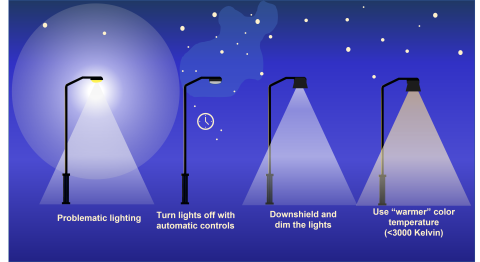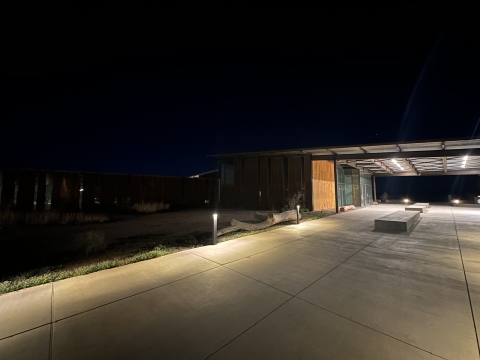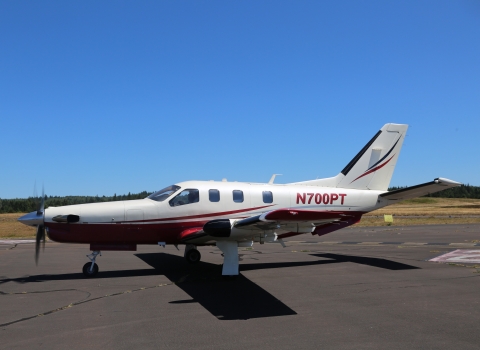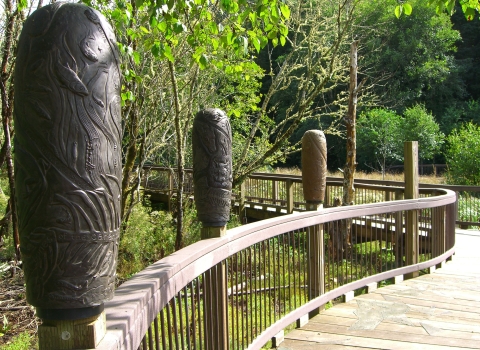The Issue with Nighttime Lighting
The night sky is an amazing part of our environment shared by both people and wildlife. The cycle of day and night is important for the natural rhythms of all living things, especially for the billions of birds that rely on it to effectively navigate their nighttime migrations.
The use of artificial lighting at night, which is light created by people, has been increasing world-wide, and it is altering the night sky. Most people can no longer step outside on a clear night and see a sky full of stars. Although nighttime lighting is intended to increase visibility and can be helpful for many reasons, it is important to use light in a way that is not detrimental to humans or wildlife, and without harm to the environment. Unfortunately, nighttime lighting is often pointed upwards at the sky, or outwards at the landscape, creating an excessive amount of light that is unnecessary.
Why is this harmful to birds? Lighting can attract large numbers of night-migrating birds from as far as 5 kilometers away. Birds can become entrapped in these areas of bright lights, circling endlessly, depleting energy stores needed for migration, and even colliding with buildings and infrastructure. This phenomenon is particularly prevalent on nights with low-cloud ceilings or foggy weather, when birds tend to migrate at lower altitudes where light reflecting on clouds can be disorienting. Multiple mass-mortality events, each involving hundreds of birds, have been documented on foggy nights during migration.
Throughout the year, nighttime lighting can affect birds by illuminating their habitats. This can cause birds to avoid habitats essential for their survival and can alter the relationships between predators and prey, all because these areas have too much light. Birds that migrate or forage offshore are also affected by and disoriented by nighttime lighting from costal areas and offshore vessels and structures.
The good news is that there are simple and easy actions we can all take throughout the year to help keep the night skies dark.
What Can We Do?
You can help solve this problem with the flip of a switch!
Turning off lights at night or taking simple actions to limit lighting so that it is most beneficial for people will make our night sky more naturally dark, helping to create a more natural environment for people and birds.
Turn It Off
- If the lighting is not needed, consider turning it off permanently or see “Timing” below.
- Birds are at greater risk from lighting during spring and fall migration on cloudy nights. Consider if lighting can be temporarily turned off April-May and August-October, or at minimum on cloudy nights those months.
- If birds become entrapped in an area of bright light that cannot be turned off permanently, turning lights off for 15 to 20 minutes can allow birds to escape the disorienting light and return to normal behavior. If you are unsure whether birds are or will be entrapped, plan regular breaks in the lighting or implement timers (see below) to allow an opportunity for birds to escape.
If you cannot turn off the lights completely at night, consider using bird-conscious lighting practices throughout the year. This is using lighting only where and when it is necessary and illuminating only the intended area. The direction of the light, how long the light is on, the color of the light, and restricting light to the minimum required for safety, are all factors to consider that can help reduce lighting’s negative effects.
Timing
- Limit lighting to necessary times only.
- Use automatic controls such as timers, dimmers, or motion sensors to turn lights on and off as needed.
Direction
- Turn off lights that face up into the sky or lights that illuminate the surrounding landscape.
- Avoid upward light scatter by shielding, selecting, or positioning lights where light is not emitted above the horizontal plane.
- Keep lighting as low to the ground as possible, only illuminating necessary structures.
Prevent light spill from windows
- Close blinds, shades, or curtains at night.
Color and Brightness
- Use amber, orange, red, or "warmer", light that is less harmful for most species because it is less likely to trigger a behavioral response. Warmer colors have longer wavelengths (>560 nm) and lower correlated color temperatures (CCT < 3000 Kelvin degrees).
- Avoid using blue, white, or "cooler", light that is least favorable for birds, other wildlife, and people. Cooler colors have shorter wavelengths and higher correlated color temperatures (>3000 Kelvin degrees).
- Keep light as dim as possible.
Benefits Of Bird-Conscious Lighting
Migrating birds are at risk of becoming disoriented and drawn into lighting, where they may collide with structures, unfortunately ending in tragedy. Giving special attention to lights during peak migration periods, in spring and fall, can help birds stay on track, increasing their chances of survival and successful breeding – which means more birds!
By applying these practices throughout the year, you can have an immediate impact on the environment around you. Not only will you be help preserve the natural cycles that are so important to people, birds, and other wildlife, you will also save more money through lower energy consumption!
Additional Resources To Help Preserve The Night Sky
- Check BirdCast to see when birds are migrating so you can make changes to lighting when it matters most.
- Learn about the “Lights Out” programs and the Urban Bird Treaty Cities network in cities around the country.
- Explore the DesignLights Consortium and International Dark Sky Association for information and examples of how you can reduce your light pollution.
- Share this printable guide for parking lot lighting best practices: ParkingLotLightingGuide.pdf (rpi.edu)
- Dim the Lights for Birds at Night!
- (Not) Lighting the Way for Birds
- The 5 Myths about Light Pollution
- Making New York City Safer for Birds: Project Safe Flight
- What it Takes to Develop a Bird-Safe City
- Visit Reducing Bird Collisions with Buildings and Building Glass









